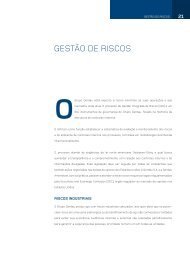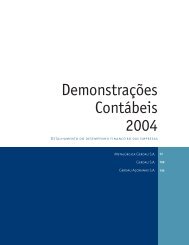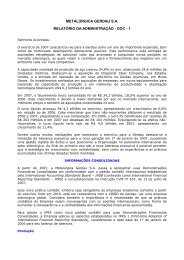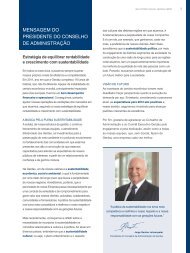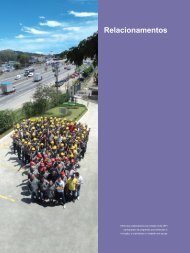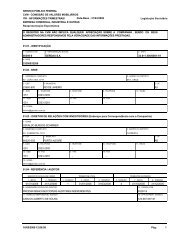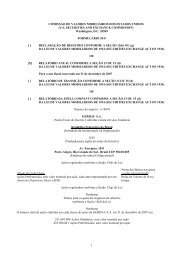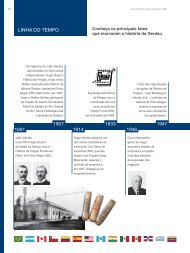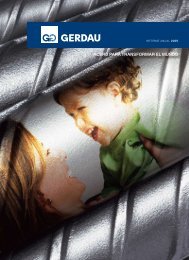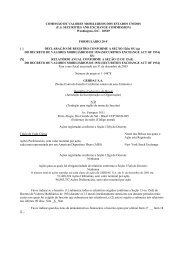Form 20-F - Gerdau
Form 20-F - Gerdau
Form 20-F - Gerdau
You also want an ePaper? Increase the reach of your titles
YUMPU automatically turns print PDFs into web optimized ePapers that Google loves.
ecoverability of the future income tax assets is considered more likely than not. Future taxable income may be higher<br />
or lower than estimates made when determining whether it is necessary to make provisions for devaluation, as well as<br />
the amount of the same.<br />
Pension and Post-retirement Benefits<br />
The Company accrues its obligations relating to employee benefit plans and their related costs, net of plan<br />
assets, adopting the following policies:<br />
• The cost of pensions and other retirement benefits earned by employees is actuarially determined using the<br />
projected benefit method pro-rated for service and management’s best estimate of expected investment<br />
performance for funded plans, growth in salaries, retirement ages of employees and expected health care<br />
costs. The discount rate used for determining the liability for future benefits is an estimate of the current<br />
interest rate at the balance sheet date on high quality fixed income investments with maturities that match the<br />
expected maturity of obligations<br />
• Pension assets are valued at fair market value<br />
• Past service costs from plan amendments are amortized on a straight-line basis over the average remaining<br />
service period of employees active at the date of amendment<br />
• The net actuarial gain or loss that exceeds 10% of the greater of the benefit obligation and the fair value of<br />
plan assets is amortized over the average remaining service period of active employees<br />
• A plan curtailment will result if there has been a significant reduction in the expected future service of<br />
present employees. A net curtailment loss is recognized when the event is probable and can be estimated, a<br />
net curtailment gain is deferred until realized.<br />
In accounting for pension and post-retirement benefits, several statistical and other factors, which attempt to anticipate<br />
future events, are used in calculating the expense and liability related to the plans. These factors include assumptions<br />
about the discount rate, expected return on plan assets, future increases in health-care costs and rate of future<br />
compensation increases. In addition, actuarial consultants also use subjective factors such as withdrawal, turnover and<br />
mortality rates to estimate these factors. The actuarial assumptions used by the Company may differ materially from<br />
actual results due to changing market and economic conditions, regulatory events, judicial rulings, higher or lower<br />
withdrawal rates or longer or shorter life spans of participants.<br />
Environmental Liabilities<br />
The Company has made provisions for potential environmental liabilities based on the best estimates of<br />
potential clean-up and compensation estimates for known environmental sites. The Company employs a staff of<br />
environmental experts to manage all phases of its environmental programs, and uses outside experts where needed.<br />
These professionals develop estimates of potential liabilities at these sites based on projected and known remediation<br />
costs. This analysis requires the Company to make significant estimates, with changes in facts and circumstances<br />
possibly resulting in material changes in environmental provisions.<br />
Derivative Financial Instruments<br />
The Company applies SFAS N o . 33, “Accounting for Derivative Instruments and Hedging Activities” as<br />
amended and interpreted.<br />
Derivative financial instruments include cross-currency interest rate swaps entered into by the companies operating in<br />
Brazil mainly for swapping fixed-rate debt denominated or indexed in U.S. dollars into variable rate debt in reais.<br />
These swaps are recognized on the balance sheet at fair value and adjustments to fair value are recorded through<br />
income. Such cross-currency interest rate swaps are not traded derivatives and have been agreed with various<br />
financial institutions in Brazil. The Company values such instruments considering quotations obtained from market<br />
participants and following an internally developed methodology that considers the forward rate of exchange of the<br />
real against the U.S. dollar and interest rates in Brazilian reais prevailing on the date of measurement. The Company<br />
understands that quotations obtained are reasonable when compared with information on similar financial instruments<br />
traded on the São Paulo Futures and Commodities Exchange (BM&F), that the internally developed valuation<br />
methodology is consistent with methodologies used by other participants in the swap market in Brazil and that its<br />
results reasonably reflect the amount that would be paid or received to settle the swap on the valuation date. Intense<br />
volatility in the foreign exchange and interest rate markets in Brazil observed during <strong>20</strong>03 has nevertheless caused<br />
significant changes in forward rates and interest rates over very short periods of time, generating significant changes<br />
in the fair value of such cross-currency interest rate swaps over similarly short periods of time. The fair value<br />
40



